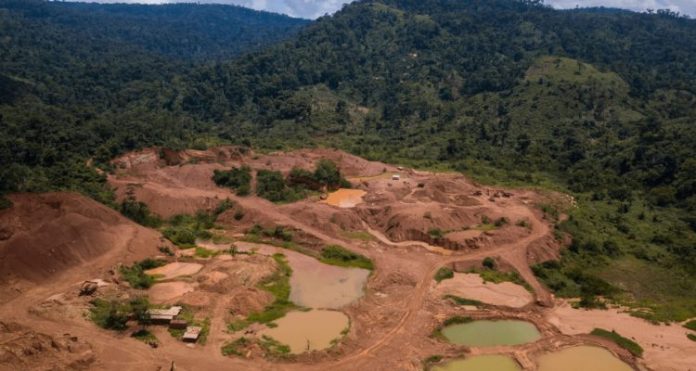|
Getting your Trinity Audio player ready...
|
Ghana was called the “Gold Coast” for a very specific reason. The West African country’s hills and rivers are flush with the precious metal. This has lured international mineral extraction companies to the region and inspired generations of Ghanians to mine their own land for the precious metal.
For most of the country’s history, mining activities involved people using handheld tools to pan, dig and mine tiny claims to suppliment their income. “It used to be that people would just dig behind the house. It was not too degrading,” says Michael Ali, Director of Mining for the Environmental Protection Agency of Ghana. But in the early 2000s this began to change when a large fleet of excavators were imported from China, he says. What was once small scale artisanal mining transformed into large, and largely unregulated mining activities.
Rapid environmental degradation followed. Excavators leveled mountains and lush forests were felled. Rivers were diverted and the soil and water contaminated. The problem got so bad that in 2017 the government issued a ban on all mining in parts of the country. It was only earlier this year that the government began to slowly start re-issuing permits and mining concessions to companies that could meet certain environmental standards. This includes having company pay bonds to guarantee the replanting trees and crops after mining operations cease. But despite the ban, unregulated strip mining is continuing at an alarming pace.
Illegal mines are prevalent in parts of Ghana. The environmental damage they cause can be extensive.

I witnessed this first hand in Kyebi, a gold-rich area about three hours drive north of Ghana’s capitol, Accra. As I pulled into a known illegal gold mining site with the regional director of the Environmental Protection Agency a few men jumped off an excavator and fled into the forest, which is an internationally known wilderness area famous for its species of butterflies. The miners were clearing land on a thickly forested mountain-side and had diverted a nearby stream for their activities. They created ponds to handle the water-waste byproduct of this kind of gold mine, known as “slime.” I saw evidence that this slime had made its way into a nearby stream that served as a tributary to a major river, which served as the source of drinking water for millions of people in the area.
Despite the mining ban, sites like this are unfortunately common in this part of Ghana. The challenge, according to the regional Environmental Protection Agency chief Felix Addo-Okyireh, was enforcement. His agency only has five vehicles to patrol and monitor a region of Ghana larger than the state of Connecticut in the U.S.
With limited resources to combat illegal mining on the ground, an international group of data scientists, government officials, companies and civil society groups turned to the sky.

Last year, Kenya, Senegal, Sierra Leone, Ghana, and Tanzania formed what is known as the Africa Regional Data Cube. This is a platform for sharing and analyzing best practices for harnessing satellite imagery to advance national goals around sustainable development. The group was formed through the Global Partnership for Sustainable Development Data, which brought journalists to Ghana to witness the data cube in action.
The satellite data for this platform is open-source and provided by NASA. In Accra last week, a few NASA staff participated in a training session with Ghanian, Senegalese, Sierra Leonean officials to discuss ways to harness and analyze satellite data. For Ghanian officials participating in the meeting, a key priority of is to use satellite data to monitor de-forestation and spot illegal mines.
The satellite data and imagery are updated several times a week as NASA’s LandSat satellites pass over Ghana. The challenge is that that satellite imagery provided by NASA is both voluminous but also not of a resolution that would provide detail for landmasses or structures smaller than 30 square meters, which is about the size of a baseball infield. Still, these satellites can generate data based on images that are being captured, so forested areas, water, cities and more each produce specific indicators that can be coded. Soon, this data will be available in near real-time for analysts to interrogate.
“By this time next year…all the data will be in the cloud. Three day old data will be available to analyze,” says Dr. Brian Killough, Technology Director at NASA Ames Research Center who participated in the training.

It was through this training, Killough tells me, that Ghanian officials suggested a way to use the data to spot new illegal mines: the presence of ponds of water where they previously did not exist. Simply searching for newly cleared land could produce false positives as people cleared land for agriculture or other purposes. But the telltale sign of new ponds of water next to newly felled forests land strongly suggests the presence of a new mine. Using this insight, Killough says his team at NASA will now create an algorithm that can automatically detect changes in geographic properties that suggest the presence illegal mines in Ghana.
Thick forests in places like Kyebi, Ghana can serve the world as carbon sinks. Mineral extraction done responsibly can serve economic and social outcomes for a rapidly developing country like Ghana. But illegal mines chop away at these forests and are far less likely to serve broader social goals.
For on-the-ground regulators like EPA official Felix Addo-Okyireh real-time information about illegal mines can help streamline how he deploys his limited resources. For policy makers back in Accra, this data can help inform strategies to combat deforestation and illegal mining. And for the rest of the world, this kind of international cooperation facilitated through Africa Regional Data Cube can accelerate progress on the Sustainable Development Goals.





